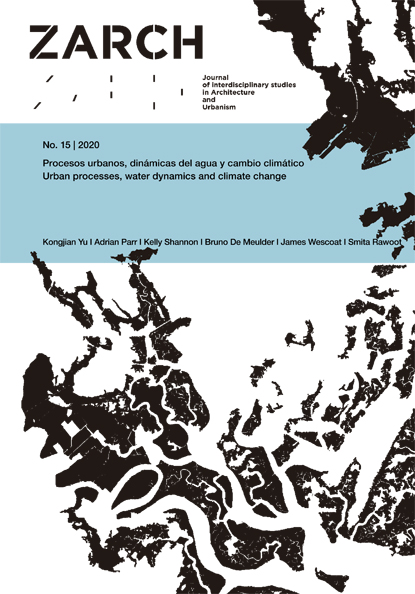HCMC: Reflejando el centro, invirtiendo la lógica contemporánea
DOI:
https://doi.org/10.26754/ojs_zarch/zarch.2020154856Palabras clave:
Sài Gòn, Chợ Lớn, Thủ Thiêm, Urbanismo del AguaResumen
Ciudad Ho Chi Minh (HCMC), la mayor aglomeración de Vietnam, es una multitud de ciudades y es donde el desarrollo espacial está intrínsecamente entrelazado con una estructura de agua en continua transformación. HCMC es una ciudad relativamente joven —la ciudadela fundacional data de finales del siglo XVIII— que, sin embargo, siempre fue compleja. Su naturaleza dicotómica original, con Chợ Lớn (China) y Sài Gòn (Vietnam), colonizó y domesticó con fuerza una ciénaga. Finalmente, fue colonizada por Francia (formalizada por la federación de Indochina 1887-1954). Posteriormente, la aglomeración experimentó un fuerte crecimiento y transformación durante la Guerra de Estados Unidos (1955-75), para explotar aún más incluso después de la (re) apertura al mercado en 1986 (Đổi Mới: el cambio a lo nuevo). El desarrollo de olas y choques (y perturbaciones significativas), de la mano de una enérgica intervención pública y una dinámica de laissez-faire, dio lugar a una extraña combinación: un entorno urbano parcialmente planificado y espontáneo, iterando entre decisiones de diseño conscientes ancladas a características territoriales (predominantemente definidas por estructuras de agua) y adiciones genéricas independientemente del terreno, entre tejidos estructurantes y no dirigidos. En medio de otra ola de crecimiento y expansión desenfrenada, la ciudad planea duplicar su centro hacia el este a través del río Sài Gòn en los distritos 2, 9 y Thu Duc, que están llenos de agua. Esto ofrece la ocasión de repensar audazmente la formación de la metrópolis deltaica tropical contemporánea. El artículo abogará por una alternativa para el futuro desarrollo de HCMC a través de la elaboración de un proyecto para el centro gemelo de Sài Gòn, previsto en un terreno interfluvial lleno de agua que está sistemáticamente permeado por canales, ramas de ríos, acequias, etc. El plan reconoce que el sistema hídrico define el registro espacial base del territorio y ancla inteligentemente el desarrollo urbano en este registro.
Descargas
Citas
Brocheux, Pierre; and Hémery, Daniel. 2009. Indochina: An Ambiguous Colonization, 1858-1954. Berkeley: University of California Press.
Cherry, Haydon. 2019. Down and Out in Saigon: Stories of the Poor in a Colonial City. New Haven: Yale University Press.
Doling, Tim. Icons of Old Saigon: The Belt Canal (Canal de Ceinture). https://saigoneer.com/saigon-heritage/5991-icons-of-old-saigon-the-belt-canal-canal-de-ceinture (accessed August 2020).
EIU (Economist Intelligence Unit). Global Liveability Ranking 2019. https://www.eiu.com/public/topical_report.aspx?campaignid=liveability2019 (accessed August 2020).
Gourou, Pierre. 1969. The Tropical World. Fourth edition, English. London: Longmans, Green and Co. Ltd.
GSO (General Statistics Office). Vietnamese government online portal. https://www.gso.gov.vn/default.aspx?tabid=714 (accessed August 2020).
Harms, Erik. 2016. Luxury and Rubble: Civility and Dispossession in the New Saigon. Oakland: University of California Press.
Harms, Erik. 2011. Saigon’s Edge: On the Margins of Ho Chi Minh City. Minneapolis and London: University of Minnesota Press.
HCMC Department of Planning and Architecture. 2019. Project Brief: The International Competition on Planning Concept of Highly Interactive Innovative Districts (HIID) – Ho Chi Minh City (District 2, District 9, Thủ Đức district).
Katzschner, Antje; Waibel, Michael; Schwede, Dirk; Lutz, Katzschner; Schmidt, Michael; and Storch, Harry, eds. 2016. Sustainable Ho Chi Minh City: Climate Policies for Emerging Mega Cities. Dordrecht: Springer.
Lau Tsz Long. 2016. Asian Cities Research: Saigon. https://fac.arch.hku.hk/asian-cities-research/saigon-1954-1960-15-further-points-of-study-conclusion/ (accessed August 2020).
Li Tana; and Anthony, Reid. 1993. Southern Vietnam under the Nguyen: Documents on the Economic History of Cochinchina (Dang Trong, 1602-1777). Singapore: Institute of Southeast Asian Studies.
Nghia M. Vo. 2011. Saigon: A History. Jefferson (North Carolina): McFarland & Company, Inc., Publishers.
Nguyen Thanh B.; Spencer, James H.; and Pham Tuan N. 2020.Development of the Ho Chi Minh City Megaregion in Historical Context: Doi Moi, Planning, and Real Estate. In The Routledge Handbook of Planning Megacities in the Global South, Deden Rukmana, ed., chapter 2. New York: Routledge.
Osborne, Milton E. 1969. The French Presence in Cochinchina and Cambodia: Rule and Response (1859-1905), 1997 edition. Bangkok: White Lotus Press.
Sasaki. 2020. “Thu Thiem New Urban Area,” https://www.sasaki.com/projects/thu-thiem-new-urban-area (accessed August 2020).
Taylor, Philip. 2001. Fragments of the Present: Searching for Modernity in Vietnam’s South. Honolulu: Allen & Unwin and University of Hawaii Press.
Ton Nu Quynh Tran. 2015. Les prémisses de l’urbanisation de Saigon-Ho Chi Minh-Ville: Empreintes du patrimoine culturel français sur l’evoltion urbanie locale. In Faire Savoirs no 12. HCMC: Centre d’Etudes urbanines et de Développement. https://faire-savoirs.mmsh.univ-aix.fr/Pdf/FS-12-2015-180.pdf (accessed August 2020).
Vo Hong Lien. s.d. The Making of Saigon: from the Nguyen Lords to 1954. https://www.academia.edu/7041136/The_Making_of_Saigon_from_the_Nguyen_Lords_to_1954 (accessed August 2020).
Wright, Gwendolyn. 1991. The Politics of Design in French Colonial Urbanism. Chicago and London: The University of Chicago Press.


